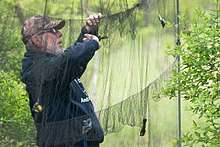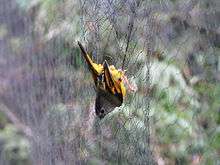Mist net
Mist nets are used by ornithologists and bat biologists to capture wild birds and bats for banding or other research projects. Mist nets are typically made of nylon or polyester mesh suspended between two poles, resembling a volleyball net. When properly deployed in the correct habitat, the nets are virtually invisible. Mist nets have shelves created by horizontally strung lines that create a loose, baggy pocket. When a bird or bat hits the net, it falls into this pocket, where it becomes tangled.

The mesh size of the netting varies according to the size of the species targeted for capture. Mesh sizes can be measured along one side of the edge of a single mesh square, or along the diagonal of that square. Measures given here are along the diagonal. Small passerines are typically captured with 30–38 mm mesh, while larger birds, like hawks and ducks, are captured using mesh sizes of ~127 mm. Net dimensions can vary widely depending on the proposed use. Net height for avian mist netting is typically 1.2 - 2.6 m. Net width may vary from 3 to 18 m, although longer nets may also be used. A dho-gaza is a type of mist net that can be used for larger birds, such as raptors. This net lacks shelves.
The purchase and use of mist nets requires permits, which vary according to a country or state's wildlife regulations. Mist net handling requires skill to optimally place the nets, avoid entangling nets in vegetation, and properly store nets. Bird and bat handling requires extensive training to avoid injury to the captured animals. Bat handling may be especially difficult since bats are captured at night and may bite. A 2011 research survey found mist netting to result in low rates of injury while providing high scientific value.[1]
Usage

Mist nets were used by Japanese hunters for nearly 300 years for capturing birds. They were first introduced into use for ornithology in the United States of America by Oliver L. Austin in 1947.[2] Mist netting is a popular and important tool for monitoring species diversity, relative abundance, population size, and demography. There are two ways in which mist nets are primarily utilized: target netting of specific species or individuals, and broadcast netting of all birds within a particular area. Targeted netting is typically used for scientific studies that examine a single species. Nets deployed in this manner often use a playback of a species' song or call, or a model of that species placed near the net to lure the targeted individuals into the net (e.g.[3] ).
Because broadcast netting captures birds indiscriminately, this technique is better suited to examining the species that occur within a specific habitat. Bird banding stations throughout the United States use this method. Typically such stations collect a set of standard measurements from each individual, including mass, wing chord, breeding status, body fat index, sex, age, and molt status.
Although setting up mist nets is time-consuming and requires certification, there are certain advantages to visual and aural monitoring techniques, such as sampling species that may be poorly detected in other ways. It also allows easy standardization, hands-on examination, and reduces misidentification of species. Because they allow scientists to examine species up close, mist nets are often used in mark-recapture studies over extended periods of time to detect trends in population indices (Dunn and Ralph 2004).
Some uses of data collected using mist net sampling are:
- Mark-recapture for population sampling
- Humane capture and relocation of small birds or bats
- Tagging and tracking
- Testing health of bird or bat species and for ectoparasite studies
- Examination of avian phenology in response to climatic and other variables
- Examination of patterns of molt
Because there is still debate as to whether or not these techniques provide precise data measurements, it is suggested that mist netting is used as a supplement to aural and visual methods of observation. One of the main disadvantages of mist nets is that the numbers captured may only represent a small proportion of the true population size (Dunn and Ralph 2004). Mist netting is a unique method in that it provides demographic estimates throughout all seasons, and offers valuable guides to relative abundance of certain species or birds and/or bats (Dunn and Ralph 2004).
Example study

Mist nets can be important tools for collecting data to reveal critical ecological conditions in a variety of situations. This summarized study, "Effects of forest fragmentation on Amazonian understory bird communities" by Richard O. Bierregaard and Thomas E. Lovejoy, used mist nets to analyze the effects of forest fragmentation on understory bird communities in terra firme forest of Central Amazon.
Data from intensive mist netting mark-recapture programs on understory birds from isolated forest reserves were compared to pre-isolation data from the same reserves to investigate changes related to isolation from continuous forest (Bierregard and Lovejoy 1989). Birds surveyed were from a variety of ecological guilds, including nectivores, insectivores, frugivores, obligatory army ant followers, forest edge specialists and flocking species. The periodic sampling by mist netting capture program provided the quantitative basis for this project. Reserves of varied sizes (1 and 10 hectare) within the Biological Dynamics of Forest Fragments project site were sampled with transects of tethered mist nets once every three or four weeks. Capture rates from isolated reserves were compared to pre-isolation rates to measure changes in population size and/or avian activity due to isolation (Bierregard and Lovejoy 1989). Data was analyzed in the following ways: capture rates per net hour as a function off time since isolation, percent recapture as a function of time since isolation, abundance distribution of species against the species rank by abundance, percent individuals banded according to species and feeding strategy, and finally, capture rates per net hour in isolated reserves against capture rates per net hour in continuous forests. A summary of the results and discussion as stated by Bierregaard and Lovejoy is as follows:
...changes in the understory avian community in isolated patches. Following isolation, capture rates increase significantly as birds fleeing the felled forest entered new forest fragments. Movement to and from the reserve is limited as witnessed by an increase in recapture percentages following isolation. Species of birds that are obligate army ant followers disappeared at the time the surrounding habitat was removed from 1 and 10 ha areas. The complex mixed-species of insectivorous flocks typical of Amazonian forests deteriorated within 2 years of isolation of 1 and 10 ha forest fragments. Several species of mid-story insectivores changed their foraging behavior after isolation of small forest reserves.
These data were collected using mist nets. Data from mist netting efforts may be used to gain a greater understanding of ecological effects of factors impacting ecosystems, such human activities or environmental changes. This is just one example of the use of mist nets as a tool for ecological and biological sciences, as well as possible ecosystem management implications mist net data offers.
Disadvantages
.png)
There are several disadvantages to using mist nets. Mist-netting is very time-consuming. Nets have to be set up properly without mistakes. An animal caught in a mist net becomes entangled, so the net must be checked often and the animal removed promptly. Disentangling an animal from a mist net can be difficult and must be done carefully by trained personnel. If an animal is heavily tangled the mist net may need to be cut to avoid injuring the animal, which damages the net as well. Also, mist nets will not capture birds in direct proportion to their presence in the area (Remsen and Good 1996) and can miss a species completely if it is active in a different strata of vegetation, such as high in the canopy. They however can provide an index to population size.[4][5]
People using mist nets must be careful and well trained since there is a possibility that the birds caught in the net can become harmed in the process. One study found the average rate of injury for birds in mist nets is lower than any other method of studying vertebrates, between 0 and 0.59% while the average mortality rate is between 0 and 0.23% (Spotswood et al. 2011). While rare, it has been suggested without scientific studies that larger birds may be more prone to leg injuries and internal bleeding. If smaller birds have problems it is with tangling issues and wing injuries. Factors that affect the injury and mortality rate are human error while handling the species, time of year caught, time of day caught, predators in the area, and size/material of the mist net.
Banders

Humans who deal with the species caught in mist nets are called banders in the United States. Banders are responsible for banding the species caught in the net so they can be tracked. In the United States, in order to band a bird or bat, one must have a banding permit. Banding permits are given to people who have gone through training and whose projects contribute to the conservation and management of the bird population. Banders are responsible for the animals caught and thus apply their training by paying attention to stress cues (for birds these include panting, tiredness, closing of eyes, and raising of feathers). If not, the animal can severely injure itself. There are different types of banding permits for birds, the Master Permit and the Sub permit. Master Permits are given to individuals who band on their own or who supervise banding operations. Sub permits are given to individuals who will be supervised while banding by a person with a Master Permit. In order to receive a permit, one must fill out an application and return it to the nearest banding office. Banders must ask for special authorization in their application in order to use mist nets, cannon nets, chemicals, or auxiliary markers (North American Bander's Study Guide 6).
See also
- Bal-chatri traps to catch birds of prey (raptors)
References
- Spotswood, E. (2011). "How safe is mist netting? evaluating the risk of injury and mortality to birds". Methods in Ecology and Evolution. 3: 29–38. doi:10.1111/j.2041-210X.2011.00123.x.
- Low, Seth H. (1957). "Banding with mist nets" (PDF). Journal of Field Ornithology. 28 (3): 115–128.
- Sogge, Mark; et al. (2001). "A targeted mist net capture technique for the willow flycatcher" (PDF). Western Birds. 32: 167–172. Retrieved 19 April 2015.
- Remsen Jr, J. V.; Good, David A. (1996). "Misuse of data from mist-net captures to assess relative abundance in bird populations". The Auk. 113 (2): 381–398.
- C. John Ralph and Erica H. Dunn, 2004 Editors Monitoring bird populations using Mist nets. Studies in Avian Biology No. 29
- Bierregaard, R.O.; Lovejoy T. E. (1989). "Effects of forest fragmentation on Amazonian understory bird communities". Acta Amazonica. 19: 215–241. doi:10.1590/1809-43921989191241.
- Dunn, Erica H.; C. John Ralph (2004). "Use of Mist Nets as a Tool for Bird Population Monitoring". Studies in Avian Biology. 29: 1–6.
- Spotswood, Erica N.; Kari Goodman; Jay Carlisle; Diana L. Humpie; Josee Rousseau; Susan L. Guers; Gina B. Barton (2011). "How Safe is Mist Netting? Evaluating the Risk of Injury and Mortality to Birds". Methods in Ecology and Evolution.
- "North American Banders Study Guide". North American Banding Council: 1–69. 2001.
